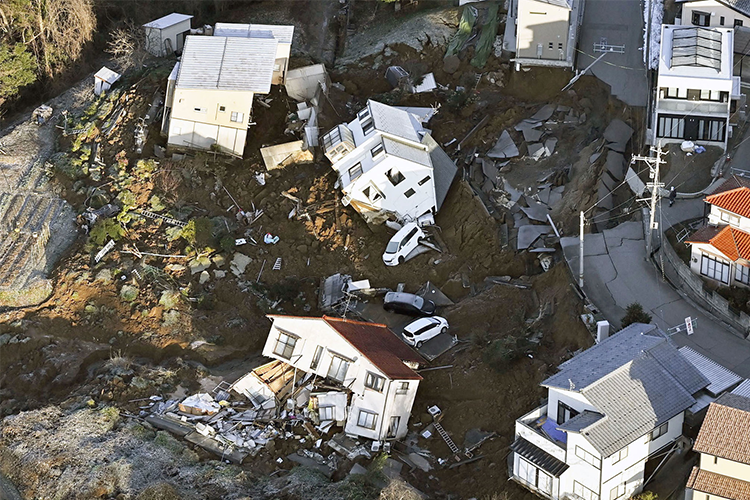
Thousands of Japanese citizens were forced to relocate and evacuate after their homes were destroyed by an earthquake. photo by Kyodo News via AP
The earthquake in Japan left immense damages to cities and even indirectly provoked an airplane crash.
For Japan, the new year started with terror. On January 1, 2024, a 7.6 magnitude earthquake hit the west coast of Japan, causing enormous damage to the country. CNN reported destroyed buildings, power lines knocked down, leaving tens of thousands of people without power, fires raged, and the quake caused a tsunami the following afternoon. At 4:10 p.m. (12:10 a.m. Mountain Time), the earthquake struck the coastline, causing an immediate emergency evacuation to be initiated for those living near the Noto Peninsula. The earthquake raised the shoreline by 820 feet and caused 14-foot waves in the Akasaki Port, leaving marks on buildings close to the shore.
While Japan experiences an immense amount of earthquakes per year – around 1,500 – this recent one was marked one of the highest magnitudes in decades. The reason for Japan’s high average is the location of the island. Geographically, Japan stands on four different tectonic plates: the Northern American, the Eurasian, the Pacific, and the Philippine. The four plates are constantly converging and are the cause of the many earthquakes in Japan.
Not only was this earthquake particularly devastating because of its high magnitude and destruction, but it even led to a travesty in the air. On the second day of January, less than 24 hours after the earthquake, an emergency aircraft set off with supplies to help the victims of the natural disaster. Aviation Week reported information from the accident, having transcripts from the crash: at roughly 5:45 p.m, the aircraft, named the De Havilland Canada Dash 8, requested to land at the Tokyo Airport. The request was approved, and they were told to hold still in “Charlie 5,” a landing lane. A few minutes before this, the planned landing of a Japanese Airline, JL516, reported that they would proceed to land at 34R, a runway on the right side of the airport. However, there seemed to be some kind of miscommunication, as the Dash 8 did not stick to the course it was told to, instead landing and crashing into the JL516, bursting into flames.
Even after a month of investigation, officials still don’t know what went wrong. There seemed to be a misconception, Aviation’s transcripts say that the Dash 8 was given instructions and permission to land on the Charlie 5, which would have kept both planes safely away from each other. But the Dash 8 crashed into the JL516 before it even landed, causing it to slide for 1,000 meters before eventually stopping. The investigators still don’t know on which side Dash 8 crashed into the plane. A survivor on the Dash 8 says that a reason for the crash could’ve been that their pilot thought they were cleared to land, and as the sun had set, did not see the other plane also landing.
The investigation could last a very long time, as crashes on landing strips are extremely rare. This tragedy only made this earthquake even more significant to the public, as it not only resulted in a record-breaking magnitude but also indirectly caused a crash between two airplanes, which is equally as rare.
Sadly, six crew members on the Dash 8 were killed in the crash. Miraculously, though, all 400 passengers on the JL516 escaped the plane and only a dozen were left with injuries. CDP updated on January 31st that the earthquake left 1,300 injured across the country, and in Ishikawa, 240 were killed and 12 are reported missing, marking one of the biggest casualty totals since 2016. The earthquake caused travesties both on and off the land. Between burning cities down, turning off power for thousands, relocating and injuring many, and killing both those in the air and on the ground, this incident is sure to go down in history as one of the most significant earthquakes ever.